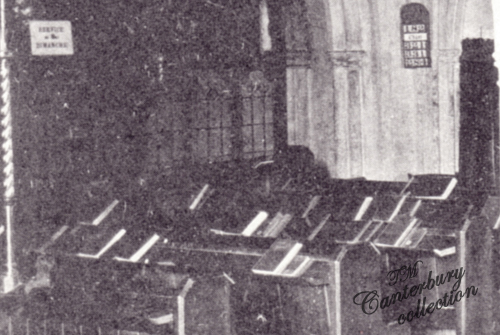
![]()
~ WALLOON OR FRENCH HUGUENOT CHURCH ~
EGLISE WALLONNE HUGUENOTE EVANGELIQUE FRANCAISE FOUNDED 1547
ESTABLISHED BY ROYAL CHARTER OF EDWARD VI., JULY 24TH, 1550
IN THE CATHEDRAL CRYPT, CANTERBURY
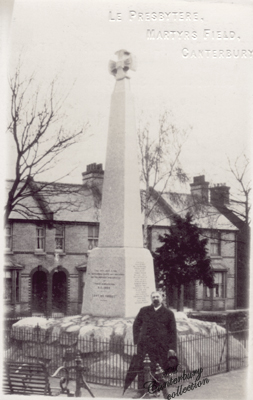
Rev. J. R. Barnabas in front of the Martyrs Memorial Canterbury
In 1634 there were approximately 900 members of the Walloon church
French Church Records available at the Canterbury Cathedral Archives (1576 - 2000)
There is a CD available from The Huguenot Society of Great Britain & Ireland (5B) which includes Registers of the Walloon Church in Canterbury
The Registers of the Wallon or Strangers' Church in Canterbury, by Robert Hovenden, pts 1 - 1891, 2 - 1894, 3 - 1898: Printed for the Huguenot society of London - C. T. King, Lymington
The Huguenots; Their Settlements, Churches, & Industries in England and Ireland by Samuel Smiles 1867 notes:
Wallon Church, Canterbury - 1581-1837
Malt House, Canterbury - 1709-1744
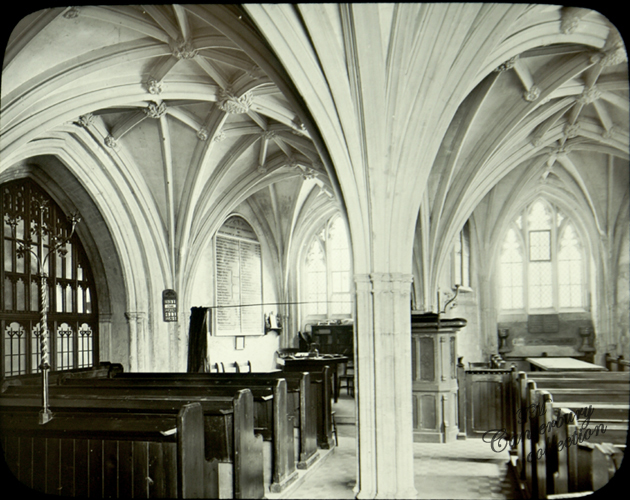
"The French Church," Canterbury Cathedral, from a Magic Lantern Slide in my collection
The Christian Life, Saturday, September 27, 1884
"With a view to perpetuating the memory of the French Walloon refugees who settled in Canterbury three centuries ago, the directors of the French Protestant Hospice in London have commissioned a well-known Kentish archaeologist to transcribe the inscriptions on the tombstones in the various churchyards in Canterbury and the neighbourhood, where many of the refugees lie buried. Of the Huguenots and other French exiles who found a home beneath the shadow of Canterbury Cathedral, and established in the crypt of that historical building a church which exists to the present day, there are now but four or fice descendants living, the number having been considerably decreased by deaths within the last few years."
"The following is the memorial, as given in the appendix to Somner's Antiquities of Canterbury, and which he entitles "The articles granted to the French Strangers by the Mayor and Aldermen of the Citty:"
Dignissimis Dominis Domino Maiori et Fratribus Consiliariis Urbis Cantuariensis Salutem.
Supplicant humilime extranei vestra libertate adm si in ista urbe Cantuariensi quat velitis sequentes articulos illis concedere.
Prior Articulus.
1. Quia religionis amore (quam libera conscientia tenere percupiunt) patriam et propria bona reliquerunt, orant sibi liberum exercitium suae religionis permitti in hac urbe, quod ut fiat commodius sibi assignari templum et locum in quo poterint sepelire mortuos suos.
Seundus Articulus
2. Et ne sub eorum umbra et titulo religionis profani et male morati homines sese in hanc urbem intromittant per quos tota societas male audiret apud cives vestros; supplicant nemini liberam mansionem in hac urbe permitti, nisi prius suae probitatis sufficiens testimonium vobis dederit.
Tertius Articulus.
3. Et ne inventus inculta maneat, requirunt permissionem dari praeceptori quem secum adduxerunt instruendi juvenes, tum eos quos ecum adduxerunt, tum eos qui volunt linguam Gallieum discere.
Quartus Articulus.
4. Artes ad quas exercendas sunt vocari, et in quibus laborare cupit tota societas sub vestro favore et protectione sunt Florenci, Serges, Bombasin, D. of Ascot Serges, etc., of Orleance, Frontz, Silkwever, Monquade, Mauntes, Bazes, &c., Stofe Mouquades.
Nomina supplicantium sunt
Hector Hamon, Minister verbi Dei
Vincentius Primont, Institutor Juventutis
Egidius Cousin, Magister operum, et conductor totius congretionis in opere.
Michael Cousin
Jacorus Querin
Petrus de Bose
Antonius Du Verdier
Philippus de Neuz
Robertus Jovelin
Johannes Le Pelu
Johannes de la Fortery
Noel Lestene
Nicholaus Dubuisson
Petrus Desportes
Jacobus Boudet
Tres Vidue
1567 - A company of the Walloons or Strangers, is allowed to inhabit within the liberties of the city, by order from the queen's council, under the direction of the Burghmote. (Hasted) they are said to have come from Winchelsea (Records of the Burghmote)
"On the figures to bee seen in the French Church at Canterbury, we have (interalia) 1. A man riding on another's head, supporting a bowl in one hand, and a fish in another. 2. An ass playing on a violin, a goat riding and blowing a pipe; a monster playing upon the harp, &c. See the Antiquarian Repertory, i. 57." - The Monthly Magazine 1808 (Figures on the Frizes in Anglo-Saxon Churches)
'…the Mayor of Canterbury and his brethren have convenient roume for receipt of straingers for a hundred families by Midsomer Daye … and desyrd to have regarde that they may not be of the meanest sort but choice to be made suche as makers of bayes, grograines …' Acts of the Privy Council 20 February 1574 (thanks to Tricia for this)
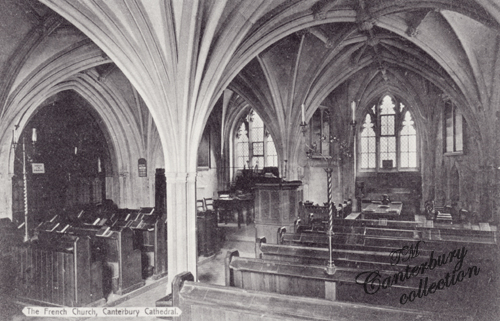
"The French Church," Canterbury Cathedral, from an old postcard
Duncombe's Historical Description of Canterbury, p. 150
When Calvin's sons, from Artois' fruitful fields,
Blind persecution's iron hand expells,
This fostering Church, maternal shelter yields.
Beneath her roof, where gospel freedom dwells,
Beneath her spacious roof, in rites divine
Lo! various sects and various tongues unite;
In blissful league, French, Germans, Britons join,
While hovering Angels listen with delight.
The descendants of the foreign Protestants believed that Queen Elizabeth had given them the use of the undercroft, but they had no written evidence of it, although search was made for it. The enquiry arose in consequence of the Archbishop at a Visitation, asking the ministers of the Walloon congregation, how them came possessed of this undercroft? The Dean replied, "by permission of the Dean and Chapter." Upon which, one of the Walloon ministers said, "I ask pardon sir, it was given by the Crown." This assertion gave the Dean offence, and he threatened that unless they proved their right, or acknowledged the error, he would shut up the doors of their church. History of the French, Walloon, And Dutch Foreign Protestant Refugees
'It was resolved that those who kept themselves at Sandwich, of our church who did not understand the Flemish language, should come here every fortnight to the preaching.' 15 Dec 1576 CCA-U47/A1 & CCA-U47/S1 (thanks to Tricia for this)
1581 - The Corporation receive 4l. 17s. 6d. of the Walloons or Strangers, resident within the city, for the use of 390 looms for half a year. (Hasted)
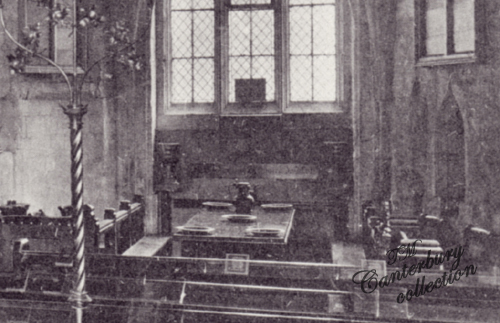 |
|
|
"The French Church," Canterbury Cathedral, details from the picture above
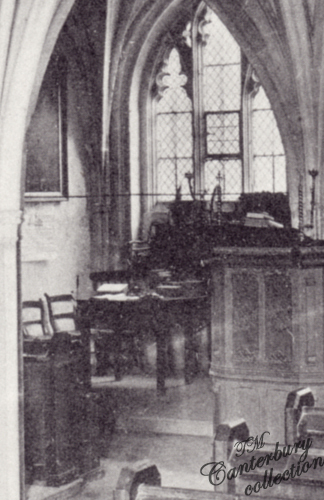
1582 - The Burghmote direct that no more strangers shall be suffered to live in the city, unless allowed by the Mayor and three Aldermen under their hands and seals. History of the French, Walloon, And Dutch Foreign Protestant Refugees
On the 22nd March, 1586, was a petition from the Company of Merchants of the Staple, to prevent the Walloons at Canterbury, (who were intending to depart from this realm and go to Direcksea in Zeland,) from exporting Woolfells (Lansd. MSS. vol. li.) History of the French, Walloon, And Dutch Foreign Protestant Refugees
1613 - By an order of the Privy Council, 2nd May, 1613, it was ordered that the said congregation should. "according to His Majesty's gracious pleasure, peaceably and freely enjoy all such privileges, liberties, and immunities, and be permitted to use their assemblies and congregations in as ample manner as heretofore hath been allowed to them in the time of Queen Elizabeth or since." History of the French, Walloon, And Dutch Foreign Protestant Refugees
April 26th, 1631 - Letter from the Privy Council to Lord Maidstone, the Mayor and Recorder of Canterbury, &c. , to assist the congregation in enforcing their rules, for the good government of the trade and congregation.
1634 - the number of communicants in the Walloon Church was increased to nine hundred. Hasted's Kent, vol. xi. 8vo. p.92
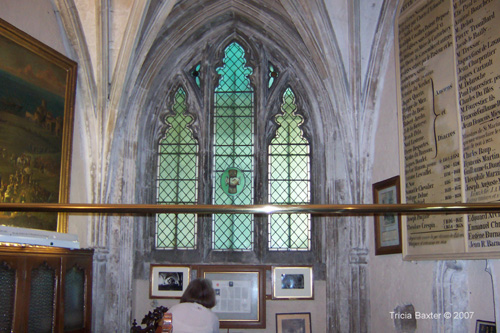
The Black Prince's Chantry, when the numbers of Walloons declined they were moved from the main crypt into this chapel.
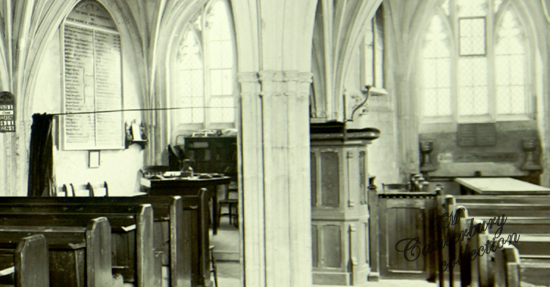
1641 - It appears that the Protestant Walloon Congregation, living in this city, came into it about the beginning of queen Elizabeth's reign, by order of the State - And as, by reason of the war in Picardy, Artois and Flanders, many other Walloons are now resorting to the city, and more are daily expected, it is agreed, that if they do conform to the government of this city, and to the orders of the congregation of Walloons, they may, for the future, live under the government of the mayor and aldermen of the city, as that congregation hath done for sixty years and upwards; it being found that, by their trade, they have been beneficial to the city. And a book is to be provided, in which their names shall be entered, with their testimonials, &c.. (Hasted)
1642 - The Walloons are to have two seals, to seal their two sorts of sayes. History of the French, Walloon, And Dutch Foreign Protestant Refugees
1645 - John Bulteel, the then minister of the Walloon Congregation at Canterbury, published in 1645 a small 4to. volume, being "A Relation of the Troubles of the Three Foreign Churches in Kent." History of the French, Walloon, And Dutch Foreign Protestant Refugees *upon reference to this volume, it appears that "a note was given to Sir John Coke by Dr. Primrose and Mr. Bulteel, of the numbers of foreigners belonging to the foreign churches,: viz:
French and Walloons of London - 1400
Dutch of London - 140
Walloons of Canterbury - 900
Dutch of Colchester - 700
Walloons of Norwich - 396
Dutch of Norwich - 363
Dutch of Maidstone - 50
Dutch of Sandwich - 500
Dutch of Yarmouth - 28
Walloons of Southampton - 36
1650 - About 1650 a curious dispute arose before the Court of Burghmote; the common carriers complaining that the master weavers had employed a nonfreeman to convey their wares to London, and the master weavers urging various reasons for so doing; amongst others, that the complainants employed the Dover waggoner to convey the goods to London, that as he travelled after sunset, (which their own carrier never did,) he had frequently been robbed of their goods, &c., &c. History of the French, Walloon, And Dutch Foreign Protestant Refugees
1651 - A bond (penes me,) from Abm Landing of Sturry, Fuller, to the Overseers appointed in the Old Hall of Weavers, that whosoever brings any Sayes to full and thick, he will full and thick them conveniently, and without neglect, and receive no piece before it has been measured at the Hall.
Order from the Burghmote Book of Canterbury - "14 Oct., 1652, the strangers dwelling in the city and suburbs now having their place of public assembly for the worship of God in the late Archbishop's Palace, and being of Theodore Crippaine's congregation, for their better government and to prevent disorders from henceforth, they are to choose and to have from amongst themselves a convenient number of politique men, who shall be sworn as hath been accustomed within the city for the dues execution of their office, and a warrant (under the hand and seal of the mayor for the time being and one of the justices of the peace,) is to be yearly granted unto the politique men for the better execution of their office, the prevention of disorders among the said strangers, and the better to enable them to keep their congregation in obedience to the government of the city."
1657 - Seven hundred and thirty-nine poor persons employed as woolcombers. History of the French, Walloon, And Dutch Foreign Protestant Refugees
1660/61 Walloon congregation
On the petition of the elders and others of the Walloon congregation,
showing that though consisting of many poor families have always maintained
their own poor without help of English parishes, whereof by order of
the court they have been discharged from paying any sess to the English
poor, yet the parishioners of Westgate [Canterbury], where the petitioners
inhabit, have taxed the petitioners towards keeping the English poor,
though the English contribute nothing to keeping the petitioner's poor.
Ordered that the tax made on the petitioners be discharged and the petitioners
not to be liable for the future to pay such tax as long as they maintain
their own poor. Q/SO/E1/f.55 (n.d.)
1661 All orders concerning
the Walloon Congregation to stand void
[Quotes former order that Walloons not to be taxed for the relief of
the English poor] but since on hearing the inhabitants of the borough
of Longport, in the parish of St. Paul's [Canterbury], ordered that
not only the former order but the order made at the present sessions,
shall be discharged and the Walloons shall be liable to be rated towards
the relief of the English poor. Q/SO/E1/f.56 (n.d.)
1662 Walloons
Whereas the Walloon congregation within the parish of Holy Cross, Westgate,
complained to the court of an assessment for the relief of the poor
of the parish dated 4 May 1662 by lands and ability, monthly to be paid,
and the churchwardens and overseers affirmed that the said assessment
is reasonably made upon the Walloon congregation and upon hearing the
matters in difference upon both sides the court confirms the said assessment.
Q/SO/E1/f.66 (n.d.)
"In 1663, the silk weavers of M. Jonon's congregation petitioned the Court of Burghmote, praying that the rules of the Hall might be re-established, which for some years past, by reason of the troubles of the kingdom, and division among themselves, had been very much neglected: certain rules are proposed for adoption, among which are - The sealer may seal only Canterbury manufacture; in case of suspicion that any piece is of foreign make, the owner be taken before the Mayor; that the officer for measuring the stuff's; "be sworne to the secresie of the trade, not to discover one man's fashion to another, &c.", City Records History of the French, Walloon, And Dutch Foreign Protestant Refugees
1663 - Assizes are holden this year, in the yard of the Old Castle, before Sir Orlando Bridgeman, and Sir Samuel Browne, knights, two of the king's justices, at the special request of the inhabitants of Canterbury, to try a question, between the citizens and the Walloons, who deny contributing to the assessments for the relief of the English poor of the city. (Hasted)
1665 - At the beginning of the Reign of Charles II. anno 1665, there were in this city 126 master weavers, their whole number here being near 1300, and they employed 759 English, so that the King thought proper to grant them a Charter in 1676, by which it appears that their numbers were then little short of 2500.
By this Charter they were enabled to become a Company, by the name and description of "The Master, Wardens, Assistants, and fellowship of Weavers."
History of the French, Walloon, And Dutch Foreign Protestant Refugees
1685 - Revocation of the Edict of Nantz, in the year 1685, occasioned a fresh influx of refugees into this country, and great numbers of them again settled at Canterbury, where, by their industry, and by introducing new articles of manufacture, they considerably improved the condition of the laboring classes, who now found full employment in the fabricating of lustrings, brocades, satins, &c. (since that period, the silk trade has gradually declined from a concurrence of various circumstances, but particularly from the rapid extension of the cotton branch, through the important inventions in machinery of Sir Richard Arkwright, and others.)
1686 - The following is from a petition to the King, from the Canterbury Walloon Church about 1686. That they were never disturbed in their marriages till 1637, when endeavours were made to exempt the second and third descent of foreign strangers, but after representation, they were again permitted to enjoy their said religion till January last. That since January, John Six and Mary le Houcq were married in the Walloon Church by M. Delon, whereupon they were excommunicated by the Consistory Court of Canterbury, for a clandestine marriage, and M. Delon suspended from his ministry. It prays a continuation of the favours originally granted - absolution of John Six and Mary le Houcq, and restitution of the minister.
History of the French, Walloon, And Dutch Foreign Protestant Refugees
1687 - The weavers have their Hall at the Blackfriars in this city. History of the French, Walloon, And Dutch Foreign Protestant Refugees
1693 - A Common Hall of the freemen is holden in the Guildhall, when the question of granting freedom to a Walloon is agitated and determined in the negative. (Hasted)
"In a copy of a petition to the Lords of Trade and Plantations, and now in the City Chamber, it is stated, that the trade of the strangers is weaving all sorts of silk, and silk mixed with wool; that in 1694 they had 1000 looms at work in this city, employing above 2700 people, but shortly afterwards their looms were reduced to 200 by the importation of East India silks and calicos; that in 1719 there were only 334 looms in use in the city, and 58 master weavers living there, who had 51 apprentices, and that no journeymen were allowed to take apprentices, but were paid by the piece, according to the richness of the work." History of the French, Walloon, And Dutch Foreign Protestant Refugees
...This City is partly inhabited by Walloons. - Magnae Britanniae Notitia 1718
"At Canterbury, aged 81, the Rev. Charles Du Bles. He had been one of the ministers of the French Congregation in that city ever since August, 1733, a period of more than 52 years. Before he came to England he had left the sight of one eye by the small pox, and more than 40 years ago he became blind of the other eye by an accident. Notwithstanding his loss of sight, he regularly and assiduously, to his great credit, discharged the duties of his function till within three weeks of his death."
The Gentlemen's Magazine 1785
"The cruel proceedings of the Duke of Alva in the Netherlands, where he represented the policy of his master, the bigoted Philip II. of Spain, is said, about the year 1567, to have driven forth as exiles 100,000 of the people. Previous to this date, however, many Dutch and Flemish Protestants had sought shelter in England, and even in Canterbury. The persecutions in France, A.D. 1547, when the entry of Henry II. into Paris was celebrated by the burning of the Huguenots in several streets, as a holocaust to sanctify his inauguration; the massacre on Saint Bartholomew's Day, instigated by his son, Charles IX., A.D. 1572; the Revocation, by Louis XIV., A.D. 1685, of that celebrated act of toleration called the "Edict of Nantes," which Henry IV. had promulgated 87 years previous, and by which his subjects were permitted to reside in all cities and places of his kingdom without being "examined, molested, troubled, or constrained to do anything in matters of religion against their consciences" - were among the chief causes that led to the immigration of the Protestant Strangers into this country. In Canterbury, the largest influx was of the Walloons, refugees from the Dutch and Flemish Protestant Churches. Certain privileges were granted to them, and they were permitted to exercise their various trades without being enforced to purchase their "freedoms."
A Walloon church, however, appears to have existed in this city even previous to 1567, for Elizabeth, A.D. 1561, as a further mark of her favour, grants them for a place of worship the Undercroft of the Cathedral. A.D. 1579, the Walloons appear to have had a congregation in the parish of Holy Cross Westgate.
The refugees were weavers in silk and stuffs, and manufacturers of sayes and woollen cloths, and the occupations connected therewith; such as fulling, dyeing, weaving, &c.
The silk manufacturers may in some degree be said to owe their introduction in this country to the establishment of the refugees, first in Canterbury, and afterwards in Spital Fields.
Many dissension's arose form time to time among the "Strangers," meeting in the Undercroft; jealousies prevailed, especially when the emigrants from Lyons, Tours, and the South of France, brought considerable additions to their numbers. The French Church separated; and although subsequently they rejoined their co-religionists in the Undercroft, we find, A.D. 1709, they met at a place then called the "Malthouse," within the precincts of the Archbishop's Palace, and their separate church was denominated the "French Uniform Church." It was about 1745, that they returned to the Undercroft. A division took place in the Walloon church in 1651; another in 1662; but a reconciliation was speedily effected; and, by an order from the King in Council, it was declared to constitute a part of the "Foreign Reformed Churches," to avoid the penalties of nonconformity, and the members of it were exempted from taxation for any poor but their own.*
A.D. 1642, the Burghmote permitted the "Strangers" to have two seals to mark their different sorts of "sayes." A.D. 1680, the Corporation voted £5 for "the distressed refugees coming out of France." This benevolence was directed to be distributed by the overseers of the Walloon church.
Driven by persecution from their native land, the Strangers were not unmolested by a similar spirit in this country. As far back as the reign of Queen Mary, some of them, probably at the instigation of Philip, had been denied an asylum, and thrust back upon their tormentors. Archbishop Laud, in the next century, broke through the toleration extended to them, excommunicated some of their members, and directed his Vicar-General to call all of them to an account who did not attend the parish Churches, in order that they might be presented and punished. Letters of the Archbishop to the King are extant (see below), wherein he denounces "the Dutch Churches at Canterbury and Sandwich, as the great nurseries of inconformity." On one of these is a note in the margin, probably by Charles himself, wherein he says, "Put me in mynd of this at some convenient tyme, when I am at Counsell, and I shall redress it."
The Scottish war at length broke out; Charles becaem occupied with more important affiars; and events followed which soon deprived the Archbishop himself of all power to molest these poor Strangers in teh land.
A.D. 1686, the Walloons were "troubled" by James II., in matters of religious forms and services. Their trials in this instance were of short duration.
Commercial restrictions, however, in conformity with the times, existed in the shape of high duties levied upon their staples. A.D. 1639, there was ordered to be paid to the Silk Office 6d. upon each pound of silk, and 6d. per pound by "foreigners," and 2d. per pound by natives upon all "stuff" manufactured.
About the year 1665, the numbers of Strangers at Canterbury were said to be 1,300. A.D. 1694, they had 1,000 looms at work, employing 2,700 people. Shortly after this period their trade declined; and A.D. 1719, they were reduced to 334 looms, and 58 master weavers. Many of the artizans had removed to London and elsewhere. The importation of silks and calicoes from India tended materially to diminish the demand for their fabrics, so that by the close of the last century, there were but ten master weavers in Canterbury, and eighty communicants to their church.
Among the Burghmote entries we note the following dispute, which arose when the master weavers, being reproached, A.D. 1650, "for employing a non-freeman in the conveyance of their goods to London," excused themselves under the plea "that the Dover waggoner travelled after sunset, which their own carrier never did, and consequently, the former was frequently robbed of their goods." This gives a picture of the general insecurity of our old London road after dark in the olden time.
A few descendants of the old families still remain in Canterbury, and their names will be readily recognised, as Marseille, DeLasaux, Minot (or Minotte), Fedarb, Lepine, Boree, Beauvais, &c. Yet in some instances, by a curious process, during the course of time the names retaining their primitive meanings have become transmuted into corresponding English appellations. Thus the Del' Ors have become the Goulds; Del' Eau, Delo or Waters; Chevallier, Hostler or Horsely; La Planche, Plank; Derousseaux, Brooks; Thiery, Terry; Redotte, Ridout; Delme or Delamer, Delmar; Corre, Carey; while Eastes was originally the ancient family of D'Este; and perhaps even some of the Birds and Nightingales came from the stranger immigrants at Canterbury, the Oiseaus and Rosignols.
The Walloon Protestant Church still meets in the Crypt of the Cathedral. Service is performed there every Sunday afternoon in the French language. A vestry still nominally exists; it once consisted of twelve Elders and as many Deacons. The number of congregation in 1858 did not exceed eighteen. The funds for the purposes of the church and the poor, once kept distinct, are now united. They consist of 33 acres of land, let at £111 per annum. The land was purchased by donations and subscriptions from various members of the French Church. The income is applied to the general purposes of the church, and to the relief of their poor. Besides the above receipts, there are other funds derived from the rents of land at Denstroode, in Blean parish, the gross annual value of which is £50, subject however to deductions for improvements. There are some cottages in Canterbury let as almshouses, rent free to poor members. There is a small dividend also from an investment in South Sea Annuities. The "Reader" to the congregation receives, out of these funds, thirty pounds per annum."
John Brent, Canterbury in the Olden Time *See Burn's "History of the French, Walloon, And Dutch Foreign Protestant Refugees." Pg. 38-54
Here is one Thing very remarkable, and fearce to be parallel'd through the whole World, which is, That under this Cathedral, is a Walloon Congregation, which while the Archbishop, Dean and Chapter are worshipping God above in the Choir, according to the Constitution, and by the Liturgy of the established Church, are underneath, opposing it as a superstitious Service. Archbishop Laud thought this so intolerable, that he resolved to reduce all these Foreign Congregations to a Conformity to the English Liturgy and Church Government, or oblige them to forsake the Realm, and to that End sent these Articles to the French Congregations in Canterbury, and the two Dutch at Sandwich and Maidstone, viz.
1. What Liturgy do you use, and whether you have not the Dutch or French in Use?
2. Of how many Discents for the most part they were born subjects?
3. Whether such as are born Subjects, will conform to the Church of England?
Requiring their Answer to them within three weeks, which they prepared to do; but being advised by the Heads of their Party at London, they pleaded their Privileges, and challenged the Exemption granted to John a Lasce and his Congregation, by the Letters Patents of King Edward VI. But to this it was answered.
1. That Letters Patents were no immutable Law in England, and
2. That they had no Title to any Privileges granted John A Lasce Because he departed out of the Realm in Queen Mary's Days
Because they could plead no Succession to him; whereupon the Archbishop, soon after, sent them these Injunctions.
1. That all the Natives of the Dutch and Walloon Congregations, in his Diocese, should repair to their several Parish-Churches, where they inhabit, to hear divine Service and Sermons, and perform all Duties and Payments required on their Behalf.
2. That all the Ministers, and all others of the same Walloon or French Congregations, which are Aliens born, shall have and use the Liturgy used in the English Churches, as the same is or may be faithfully translated into French or Dutch. The Congregations were much disturbed at these Injunctions, and sent some of their Ministers, and Lay-Elders to the Archbishop, to desire his Favour for the enjoying their Privileges, to whom, when they had delivered their Plea, he answered.
1. That none of their Reasons should hinder him from proceeding in inforcing his Injunctions.
2. That their Churches were Nests and Occasions of Schism, which he would prevent in Kent, as well as he could.
3. That it is better to have no foreign Churches in England, than that they should occasion any Prejudice, or Danger to the Church Government there.
4. That they endeavoured to make themselves a State within a State, and had bragged that they feared not his Injunctions; but he doubted not but the King would maintain him in them.
5. That Dissipation of their Churches and the Maintenance of two or three Ministers, was not to be put in the Ballance with the Peace and Happiness of the Church of England; and therefore,
6. He was resolved to have his Injunctions put in Execution; and if they did not conform to them, it should be at their Peril. They feared his Displeasure; but being unwilling to submit, they used all Interests to avoid it, and by Delays to put off their Execution, that the Scotch Wars came on, and so they retained their old Customs, in which they continue to this Day.
Magna Britannia Antqua & Nova 1738
"The service was performed in the under croft, according to the usages of the Reformed Church of France, until about thrity or forty years since, when, upon M. Mieville being offered a benefice in the Church of England, the vestry consented to allow the use of a translation of the English Liturgy.
Prior to the establishment of this congregation, there had been one or two secessions fromt he congregation at the Undercroft. One of these existed in 1651, for they presented a petition to the Burghmote, as strangers assembling in the late Archbishop's palace, and of Theodore Crippaine's congregation. They were united again to the old congregation by the interference of the Colloque in 1654. The order relating to this congregation, as it refers to the duties of the politic men, is given at length in the note below.*
It appears from numerous letters and petitions copied into the register of this church, that it was formed about 1709, and was a secession fromt he Walloon Church assembling at the undercroft of hte cathedral, and then consisted of about three hundred persons. It was called the "French Uniform Church,"and the congregation met at a place called the malthouse.+
The History of the French, Walloon, Dutch and other Foreign Portestants, 1846 (*see above Oct 14, 1651) +"There was in 1720 a French chapel or meeting house within these precincts, (Canterbury cathedral and priory) for Anne Herault of Canterbury, spinster, by her will, proved that year, gave the sum of £10 to the adorning and repairing of the French chapel or meeting house in the Archbishop's Palace here, belonging to the French Congregation." Hasted's Kent, vol. iv. fol. p. 502. This was probably the malthouse chapel which was situate where formerly the dissenting congregation of the Rev. Edward Perronet assembled, when a French Church, the Church of England's rites and ceremonies were performed. The house now occupied by Mr. Austin near the green court is built on the site on which the malthouse stood.
1793- Death - at Canterbury in his 90th year, Mr. John Halbet, of the Walloon congregation, in that city. KR
"Founded by Edward the Black Prince in 1363, to commemorate his marriage with Joan the Fair Maid of Kent, in the under-croft of the South Transept. The first congregation of refugee "Strangers" in England was formed in Canterbury in 1547 and owed its existence to the presence of the eminent foreign reformers invited by Archbishop Cranmer. The first use of the crypt for the services of the Walloon and Huguenot Church appears to have been granted by Queen Elizabeth with the consent of the Dean and Chapter in 1575. The area formerly occupied by the congregation extended across the entire width of the Prior Ernulf's crypt from the west wall to the Lady Chapel, the Chapel of St. Gabriel and the Black Prince's Chantry being used as vestries. The tradition that the Strangers carried on their occupation of weaving in the crypt has no foundation in fact and seems to be simply a mistaken induction from the circumstances that the alien immigrants who worshipped in the crypt were also weavers in the city."
Canterbury Views c. 1903
The 1851 census for religious worship, gives statistics for the Walloon church attendence as follows:
Morning - 0
Afternoon - 21
Evening - 0
The French Church. The undercroft of the South-East Transept was the Black Prince's Chantry, founded by the Prince on the occasion of his marriage in 1363. It is used for Sunday services (3 pm) by a few of the descendants of the Protestant exiles from France and Flanders who were permitted to worship here by Queen Elizabeth in 1561. Tradition has it that they were allowed at the same time to set up their silk-looms and to live in the other part of the crypt.
Ward Lock Guide to Canterbury and North-East Kent
Thomas Simon (2nd S. xii.510; 3rd S. i. 178.) - In reply to the inquiries of P. S. Carey and Clio, I beg to state that there were refugees of the name of Simon, at Canterbury, soon after 1572. I add two matches, which I have recently discovered, and which will show this; and some others, which may assist your correspondents in their ivestigation. A search at the General Register Office, in the Register of Baptisms in the London Walloon Church, would probably be attended with success:
At Canterbury.
"1593. Melcio Simon and Ysabeau Descamps.
1605. Jaque Simon (son of Melchior Simon) and Susane Descamps.
1646. Danl Agache and Marie Simon.
There was at Canterbury in 1650 a mutual release from a contract of marriage, a rather unusual occurrence. The parties to it were Ernoult du Emme and Marie Simon. John S. Burn. Notes and Queries, 1862
During Queen Elisabeth's reign, the Walloons, driven from the Netherlands by persecution on account of their religious tenets, found an asylum at Canterbury, where they introduced the weaving of silk and stuffs; their descendants are still numerous in the city and its neighbourhood, and continue to use, as their place of worship, the crypt under the cathedral, which was granted to them by Elizabeth, and where the service is performed in the French language.
Charles II., on his return from France at the Restoration, held his court at the royal palace at Canterbury, for three days; and in 1676, that monarch granted a charter of incorporation to the emigrant silkweavers settled in the city, who, on the revocation of the edict of Nantes, in 1685, were joined by a considerable number of other artisans from France.
1848 Topo
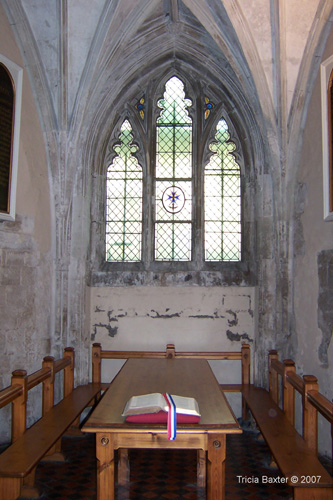
The Black Prince's Chantry, when the numbers of Walloons declined they were moved from the main crypt into this chapel.
February 26, 1901 (N.Y. Tribune)
The French Huguenot refugees, who have met in the crypt of Canterbury Cathedral ever since 1550, when a royal charter of liberty to worship was granted to them, have sworn allegiance to King Edward VII. Their pastor, the Rev. Jean R. Barnabas, preached a memorial service for her late Majesty Queen Victoria, and then, according to ancient custom, the oath of allegiance was taken, the pastor with uplifted hands making the solemn declartion, to which the people responded "Amen."
1907 - Anniversary of the French Church - The 360th anniversary of the French Protestant Church in the crypt of Canterbury Cathedral will be celebrated on Sunday at 3 pm. The Rev. Jean R. Barnabas is the minister, and the preacher will be the Rev. Pearson McAdam Muir, D.D. Minister of Glasgow Cathedral. The Mayor, the Sheriff, and a number of the Councillors have promised to attend in state.
See THE WEAVERS for more information on the fabric industry in Canterbury
The following were ministers of this congregation
Rector Hamon pastore? de 1564 a 1581??
Anthoine Lescailet (died 1596)....1581
M. Noe....1592
Samuel Le Chevalier..............1595
Philippe Delme, died 22nd April, 1653..........................1619
Jean Bulteel..................1630
Paul Georges....................1630
Joseph Poujade (1647)....................1638
Paul Georgier, (died 14th March 1689)............1648
Pierre Le Keux, formerly minister at dover ..........1653
Philipe Le Keux .......................................1654
Elie Paul D'Arnade...................1664
Arnaud Boucherie, (died 3rd July, 1685)...........1670
M. Delon (died 28th December...................1686
Pierre Trouillart...........1686
Jacob Le Bailly (died 16th July, 1698......1690
M. --------- Trepsac.............1698
Jacques Gast de Lavaure.................................1699 *Married at Hungerford Chapel to Marie Bossatran of Wandsworth
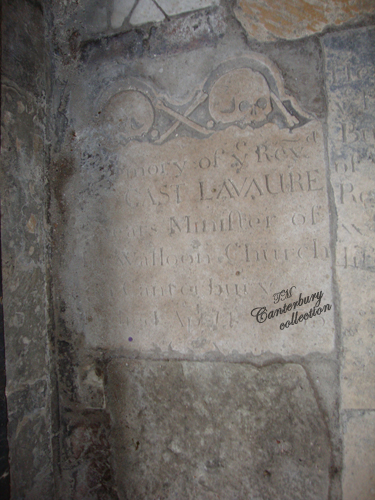
In the Cloisters, Canterbury Cathedral
M. Cherpentier...............1700 *In a petition he presented to the Abp. of Canterbury, he states that "his family has suffered very much for the Protestant religion, especially his father, who was put to death by the dragoons and died as a martyr in ye year 168(3)." The Rev. Mr. Cherpentier appears to have waited long for his priest's orders, and finding his congregation beginning to weary at the delay, ventured at Christmas 1711, to administer the sacrament, without having received his orders, which circumstance, added to the alleged interference of "their enemies, the congregation of the Walloon Church," occassioned the Archbishop to withold his orders.
Jaques Cartault...................1702 *married at Hungerford Chapel, 8 October 1702, to Dame Madelain Pierresene
1733 - 1785 - Rev. Charles Du Bles *see obit above
John Francis Mieville (will of John Francis Mieville*, Minister of the French Church at Canterbury, Kent - March 13, 1840)
*he leaves everything to a couple of unidentifiable women, one possibly his housekeeper as he describes her as "now residing with me", naming his brother Andrew Amedee Mieville and a nephew as Executors. Thank you to Alison for this information
1881 - Joseph A. Martin* - Pastor of French Church Cathedral
1882 - Rev. Joseph Augustus Martin B.D. Reader - Hours of Service: 3 pm.
1889 - Rev. J.A. Martin, B.D.
1899 Rev. J. Barnabas appointed pastor?
1903 - Rev. John R. Barnabas, pastor. Hours of Service: 3 pm. (born France)
1917 - Church of the Huguenots, Cathedral Crypt, Pastor, Rev. Jean R. Barnabas, Cathedral Crypt - Services: Sun 3.
From the Register Booke of Christeninges, Marriages and Burialls in Saint Dunstan, J. M. Cowper - Francis William Durand, after being Minister of the French Church in the Crypt of the Cathedral, for forty years, was buried in Holy Cross Church, Sept. 20, 1789, aged 74 years.
Joseph Augustus Martin was born in France c. 1822, but was a British Subject, he was married to Sophia, and had a daughter named Vita who was born in St. Pancras in London in 1866. In 1881 the family was living at 27 Whitstable Road in St. Dunstans, Canterbury. In the 1870's he was assistant minister in the French Church in London. He was living in St. Paul Hammersmith, London. There is a death of a Joseph Augustus Martin in the Sept qtr 1889 in Blean at age 67 born c. 1822 that is likely to be him.
In the Register book of the parish of St. Peter:
(An Altar Tomb)
In hopes of a Joyfull Resurrection
Here lieth the Body of ESTHER
Wife of ye Revd PAUL FOURESTIER
Minister of the Walloon Church
in this City, and Daughter of Peter
and Anne Le Grand of Canterbury
who are also interred in this
Church Yard. She hath had Issue
three Children Peter, Paul & Esther
Peter died Feby 28 1719 and is buried
near this place Paul and Esther are
still living. She was born ye 6th of Decr 1685
& departed this liefe ye
21st Febry 1738 Aged 53 years.
(On the Western Face of this Altar Tomb)
JACOB AGACE
Married the Daughter
of the Revd PAUL FOURESTIER
died 18th February 1782
Aged 62 Years.
Esther relict of the above
and Daughter of the Rev PAUL
and ESTER FORESTIER*
Also
...........................
...........................
Blest fruits thereof.
(Mrs. Esther Agace, widow, aged 80, buried in the Family Vault, Dec. 1st 1803, from Clapton, in Middlesex. - Register)
Index of Wills
Jonas LE KEUX (Canterbury); (the poore of the Walloon church at Flushing (Holland), and at Canterbury mentioned) 1656 folio 429
